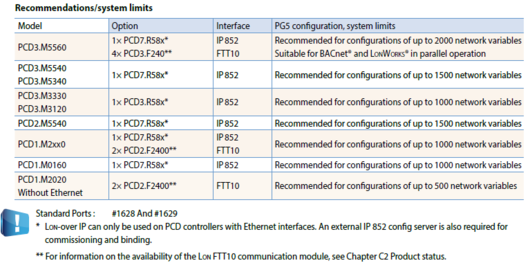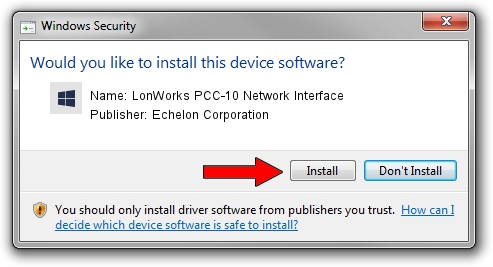Status monitoring, maintenance, download of modified programs – all this can be done from a remote PC with Internet connection using the RNI software. Requirements: a PC with Internet access, Easylon Interface and the RNI software at the LON network.
OpenLDV™ ReadMe File
Release 3.3A, September 2006
Copyright © 2003 – 2006 Echelon Corporation
All Rights Reserved
- The freely configurable network interface can manage up to 249 variables. WAGO's 753-648 LON® Module independently connects LonWorks® field devices to the WAGO-I/O-SYSTEM 750. Numerous interfaces to the supported protocols (e.g., BACnet IP, KNX IP, DALI or SMI) provide maximum flexibility.
- USB100 USB-Interface, connects to the USB port of a PC, supports LonMark TP/FT-10, TP/XF-1250, and TP/RS-485. LON Interface for USB. USB interface connecting to LON networks via TP/FT segments Compatible with LNS applications in high-performance LNS/VNI access mode Simultaneous operation of LNS applications and LPA or LSD tools.
- NodeUtil Node Utility can be used to diagnose and configure LONWORKS® network interfaces, routers, and devices. Using Node-Util it is only possible to view and modify the configuration of a single device, it is not possible to manage a device’s configuration in the context of the network containing the device.
The OpenLDV driver provides LONWORKS® tool developers with a unified Windows software interface for sending and receiving LonTalk® messages through Echelon's family of network interfaces including:
·i.LON® 10 Ethernet Adapter;
·i.LON 100 Internet Server;
·PCLTA-20 and PCLTA-21 PCI Network Interfaces;
·PCC-10 PC Card Network Interface;
·SLTA-10 Serial Network Interface; and
·U10 and U20 USB Network Interfaces.
The OpenLDV driver also works with Echelon’s legacy network interfaces such as the PCLTA, PCLTA-10, and SLTA/2.
When used in conjunction with the i.LON 10 and i.LON 100, the OpenLDV driver provides outstanding security including RC4 encryption, MD5 authentication, and protection from replay attacks, as well as transparent, fault-tolerant session recovery when the IP connection or power to the i.LON network interface is interrupted. Support is provided for uplink connections, wherein a remote network initiates a call, either dial-up or broadband, into a service center. Uplink connections are commonly used in large remote access systems in which hundreds or thousands of sites report back to a single service center.
The OpenLDV installer installs all required drivers needed to access the PCLTA-20, PCLTA-21, PCC-10, i.LON 10, i.LON 100, U10 and U20 network interfaces. To use other legacy network interfaces, install the appropriate network interface driver in addition to the OpenLDV installer.
For Windows developers, the development of PC-based network tools will be simpler and less time-consuming using Echelon's LNS® Network Operating System software. In addition, network tools that use LNS will have higher performance levels than those that use OpenLDV. Contact Echelon Sales at www.echelon.com/sales if you would like assistance in determining whether you should develop your network tools with LNS or with OpenLDV.
Network tool installer programs normally incorporate the OpenLDV installer; however, if the network tool does not include the OpenLDV installer, the end-user can download and install the OpenLDV driver separately.
Network tool developers use the OpenLDV Developer's Kit to build support for the OpenLDV driver into their network tools. The OpenLDV Developer’s Kit may be downloaded from www.echelon.com/downloads.
The OpenLDV driver is licensed royalty-free for use exclusively with Echelon's family of network interface products.
This file contains important information about the OpenLDV installer. Additional information and updates, including critical updates, may be available in Echelon’s Downloads web page at www.echelon.com/downloads.

- Pentium® III, 366MHz equivalent processor or higher
- Microsoft® Windows® 2000, XP, or Server 2003
- 128MB RAM or more as required by operating system
- 10MB of available hard-disk space
- Available USB 1.1 or 2.0 port (if using U10 or U20 USB Network Interfaces)
You must have Administrative Privileges in order to install this software.
If you are using the U10 or U20 USB Network Interface, install the OpenLDV driver before plugging the network interface into a USB port.
Double-click the OpenLDV installer (OpenLDV330A.exe) to begin the OpenLDV installation. OpenLDV330A.exe is available on CD-ROM or from www.echelon.com/downloads. The Welcome to the InstallShield Wizard for Echelon OpenLDV 3.3 window appears. Click Next to continue. This opens the License Agreement window.
Read the terms of the license agreement and, if you agree to the terms, click I Accept to continue. This opens the Installing Echelon OpenLDV 3.3 window. The installer completes the OpenLDV driver installation.
Normally, you are not required to reboot your computer after installing the OpenLDV driver and no completion dialog appears when the installation completes successfully. If the OpenLDV driver is not installed successfully, a dialog appears to notify you of the problem.
If you are using the i.LON 10 Ethernet Adapter or the i.LON 100 Internet Server, you may need to modify the configuration (such as the IP address) for those devices by opening LonWorks Interfaces in the Windows Control Panel. Consult the LonWorks interface online help for more information. Advanced users may wish to create specialized connection profiles using the xDriver Profile Editor. For more information on the xDriver Profile Editor, see Chapter 2 of the OpenLDV Programmer’s Guide, xDriver Supplement.
To develop OpenLDV applications, install the OpenLDV Developer's Kit available from www.echelon.com/downloads.
The OpenLDV driver is installed using Microsoft Windows Installer technology. Some components of this product were also present in earlier installations of Echelon products that did not follow the Windows Installer installation rules. As a result, installing some older Echelon products after installing the OpenLDV driver may revert some files to obsolete versions.
Workaround: If you experience software behavior changes as a result of another software installation, you can repair this product installation through the following procedure:
- Open the Windows Control Panel.
- Double-click Add or Remove Programs.
- Click Echelon OpenLDV 3.3 in the program list.
- Click Click Here for Support Information.
- Click the Repair button.
This section lists the changes included in OpenLDV 3.3A.
6.1Problems Fixed
The following problems have been fixed in OpenLDV 3.3A. Numbers in parentheses at the end of the fix descriptions are Echelon's internal problem tracking IDs.
- The PCLTA-20 driver does not recognize the new RoHS-compliant PCLTA-20 network interface card. (42396)
This section lists the changes included in OpenLDV 3.3.
7.1Certified PCLTA-20, PCLTA-21, and PCC-10 Drivers
The Echelon network interface cards formerly supported by a separate driver installation have been incorporated into the OpenLDV installation. The driver for these cards has been certified by Microsoft for compatibility with the Windows 2000, Windows XP, and Windows 2003 operating systems.
These interfaces are still defined and managed through the LonWorks® Plug n’ Play item in the Windows Control Panel.
7.2Problems Fixed
The following problems have been fixed in OpenLDV 3.3. Numbers in parentheses at the end of the fix descriptions are Echelon's internal problem tracking IDs.
- LonScanner packet timestamp can drift significantly. (40860)
- Windows handle leak when repeatedly opening and closing driver sessions. (39204)
The following are known OpenLDV problems and their workarounds. The numbers in parentheses at the end of the problem descriptions are Echelon's internal problem tracking IDs.
8.1Interaction with LNS 3, Service Pack 8, Update 1 (36682)
Echelon released a patch update to the LNS product in March 2003 named “LNS 3, Service Pack 8, Update 1” (LNS3SP8U1) that is not forward compatible with OpenLDV 3.3A and later releases.
This patch will cause problems for any computer with OpenLDV 3.3A installed, if it is installed after OpenLDV 3.3A. It will overwrite the newer OpenLDV components, causing them to revert back to older versions. This will cause all functionality added in OpenLDV 3.3A—such as USB network interface support—to be lost, and may cause programs that use new OpenLDV 3.3A API calls (see ldv32.h in the OpenLDV 3.3 Developer’s Kit) to completely fail to run.
The LNS3SP8U1 patch is included in some versions of the Echelon i.LON 10, i.LON 100 v1.1 and LonMaker® 3.13 product installations, and may also be embedded in installations from other companies that license and redistribute the LNS runtime. Although it is being phased out of product software, it may be encountered for some time to come. The OpenLDV 3.3A installation can be used as a replacement for LNS3SP8U1, as it corrects all of the problems corrected by that update, plus provides new USB functionality.
This problem will only manifest itself if LNS 3 is installed on the computer. If LNS Turbo or a later version is installed, this problem will not occur.
Workaround: If you suspect that you have encountered this problem, go through the procedure described in Repairing OpenLDV Installations. The OpenLDV 3.3A installation will then repair itself and function correctly. If this is not the problem, there is no harm in running the repair operation.
8.2Interaction with LNS 3.08 (36258)
After installing OpenLDV 3.3A over LNS 3.08, uninstalling OpenLDV 3.3A will cause LNS 3.08 to become inoperable. OpenLDV 3.3A provides a partial upgrade to LNS 3.08 that may not be completely reversed by uninstalling. If your product installation embeds the OpenLDV 3.3A installation, do not attempt to uninstall it as part of your uninstallation process.
Lonworks Interfaces Download Windows 10
Workaround: If LNS 3.08 has been inadvertently broken by uninstalling OpenLDV 3.3A, reinstall OpenLDV 3.3A.
8.3Some Installations Require Reboot (32205, 32177)
On Windows 2000, the OpenLDV installation will require a reboot before LonWorks Interfaces appears in the Windows Control Panel or before the OpenLDV driver is accessible to all users.
Lonworks Interfaces Application
On all Windows versions later than Windows 2000, if the OpenLDV driver is installed by one User, a reboot is necessary before logging onto another User and using OpenLDV. Logging off one User and onto another is not sufficient.
The installation does not always inform the user when a reboot is required.
Workaround: If some OpenLDV functionality is not working after installation, but before reboot, try again after rebooting your computer.
Lonworks Download
8.4LonWorks Interfaces Missing from Control Panel (41439)
On a small number of Windows 2000 installations, LonWorks Interfaces may not appear in the Windows Control Panel, even after a reboot. This has been seen on a small number of computers that have been upgraded from earlier versions of Windows to Windows 2000.
Workaound: On Windows 2000, follow these steps:

- Right-click My Computer on your desktop or Start menu and select Properties.
- Select the Advanced tab.
- Click the Environment Variables button.
- Select the Path variable on the System Variables list.
- Edit the Path variable to place the OpenLDV installation directory earlier in the list of directories, but be sure to place it after the standard Windows root and System32 directories.
- Reboot and look for LonWorks Interfaces in the Windows Control Panel.
Since the OpenLDV driver is designed to be incorporated into third-party software products, the documentation required to use the OpenLDV driver is included with the third-party software product that includes the OpenLDV driver.
If you do need to create Windows applications using the OpenLDV driver, download the OpenLDV Developer's Kit available from www.echelon.com/downloads.
The license that governs the use of the OpenLDV driver is agreed to before downloading the OpenLDV driver from the Echelon Web site, or is included as part of the license displayed by any software incorporating the OpenLDV driver. The license is also available from the LonWorks OpenLDV directory in license_OpenLDV.htm.
The company that writes an application that uses the OpenLDV driver is required to provide technical support for their product. For technical support purely in relation to the OpenLDV driver apart from use of the OpenLDV driver by a client application, contact www.echelon.com/support.
Echelon welcomes your feedback on the OpenLDV driver. Please send non-technical support-related comments and feedback on the OpenLDV driver to OpenLDV@echelon.com.
